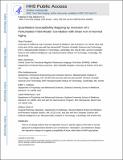Quantitative Susceptibility Mapping by Inversion of a Perturbation Field Model: Correlation With Brain Iron in Normal Aging
Author(s)
Poynton, Clare B.; Jenkinson, Mark; Adalsteinsson, Elfar; Sullivan, Edith V.; Pfefferbaum, Adolf; Wells, William M.; ... Show more Show less
DownloadQuantitative Susceptibility.pdf (1.947Mb)
OPEN_ACCESS_POLICY
Open Access Policy
Creative Commons Attribution-Noncommercial-Share Alike
Terms of use
Metadata
Show full item recordAbstract
There is increasing evidence that iron deposition occurs in specific regions of the brain in normal aging and neurodegenerative disorders such as Parkinson's, Huntington's, and Alzheimer's disease. Iron deposition changes the magnetic susceptibility of tissue, which alters the MR signal phase, and allows estimation of susceptibility differences using quantitative susceptibility mapping (QSM). We present a method for quantifying susceptibility by inversion of a perturbation model, or “QSIP.” The perturbation model relates phase to susceptibility using a kernel calculated in the spatial domain, in contrast to previous Fourier-based techniques. A tissue/air susceptibility atlas is used to estimate B[subscript 0] inhomogeneity. QSIP estimates in young and elderly subjects are compared to postmortem iron estimates, maps of the Field-Dependent Relaxation Rate Increase, and the L1-QSM method. Results for both groups showed excellent agreement with published postmortem data and in vivo FDRI: statistically significant Spearman correlations ranging from Rho=0.905 to Rho=1.00 were obtained. QSIP also showed improvement over FDRI and L1-QSM: reduced variance in susceptibility estimates and statistically significant group differences were detected in striatal and brainstem nuclei, consistent with age-dependent iron accumulation in these regions.
Date issued
2014-09Department
Harvard University--MIT Division of Health Sciences and Technology; Massachusetts Institute of Technology. Computer Science and Artificial Intelligence Laboratory; Massachusetts Institute of Technology. Department of Electrical Engineering and Computer ScienceJournal
IEEE Transactions on Medical Imaging
Publisher
Institute of Electrical and Electronics Engineers (IEEE)
Citation
Poynton, Clare B., Mark Jenkinson, Elfar Adalsteinsson, Edith V. Sullivan, Adolf Pfefferbaum, and William Wells III. “Quantitative Susceptibility Mapping by Inversion of a Perturbation Field Model: Correlation With Brain Iron in Normal Aging.” IEEE Trans. Med. Imaging 34, no. 1 (January 2015): 339–353.
Version: Author's final manuscript
ISSN
0278-0062
1558-254X